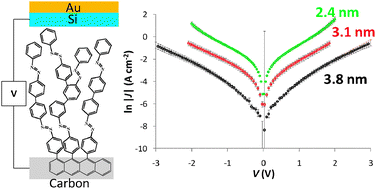This paper discusses the electronic properties of molecular devices made using covalently bonded molecular layers on carbon surfaces with evaporated silicon top contacts. The Cu “top contact” of previously reported carbon/molecule/Cu devices was replaced with e-beam deposited Si in order to avoid Cu oxidation or electromigration, and provide further insight into electron transport mechanisms. The fabrication and characterization of the devices is detailed, including a spectroscopic assessment of the molecular layer integrity after top contact deposition. The electronic, optical, and structural properties of the evaporated Si films are assessed in order to determine the optical gap, work function, and film structure, and show that the electron beam evaporated Si films are amorphous and have suitable conductivity for molecular junction fabrication. The electronic characteristics of Si top contact molecular junctions made using different molecular layer structures and thicknesses are used to evaluate electron transport in these devices. Finally, carbon/molecule/silicon devices are compared to analogous carbon/molecule/metal junctions and the possible factors that control the conductance of molecular devices with differing contact materials are discussed.

You have access to this article
 Please wait while we load your content...
Something went wrong. Try again?
Please wait while we load your content...
Something went wrong. Try again?


 Please wait while we load your content...
Please wait while we load your content...